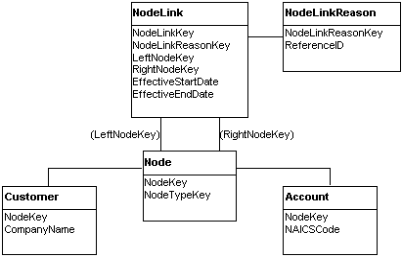IEE customer-to-account example
Using the Customer-to-Account example described above, the following illustration shows how the database captures the same relationship. For simplicity, the illustration includes only a few table elements.

The NodeLink table identifies the link between customer and account, using the LeftNodeKey and RightNodeKey. The NodeLinkReason table describes the types of business objects involved in the relationship.
As in the example above, the customer, YourCustomerLLP, has one account: 1000101.
Customer table
|
Customer ID |
Company name |
|---|---|
|
100 |
YourCustomer LLP |
Account table
|
NodeKey |
NAICS code |
|---|---|
|
100 |
1000101 |
Node table
|
NodeKey |
Node type |
|---|---|
|
100 |
Customer |
|
200 |
Account |
NodeLink
|
NodeLink key |
NodeLink reasonKey |
LeftNodeKey |
RightNodeKey |
Effective date |
End date |
|---|---|---|---|---|---|
|
33333 |
44444 |
100 |
200 |
1/1/1970 |
1/1/2070 |
NodeLink reason
|
NodeLinkReasonKey |
ReferenceID |
|---|---|
|
44444 |
Customer_To_Account |
This example shows that the NodeLink table defines the actual relationship between the two NodeKeys. In this scenario, NodeKey 100 represents the customer, YourCustomerLLP, and NodeKey 200 represents the account, 1000101.
The NodeLink table captures the relationship in the LeftNodeKey and RightNodeKey fields. In this scenario, the LeftNodeKey represents the customer (100) and the RightNodeKey represents the account (200).
The NodeLink table doesn't describe the relationship completely. The application or an SQL query cannot easily ascertain, from this table, exactly what types of business objects are being linked. The types of linked business objects is stored in the NodeLinkReason table.